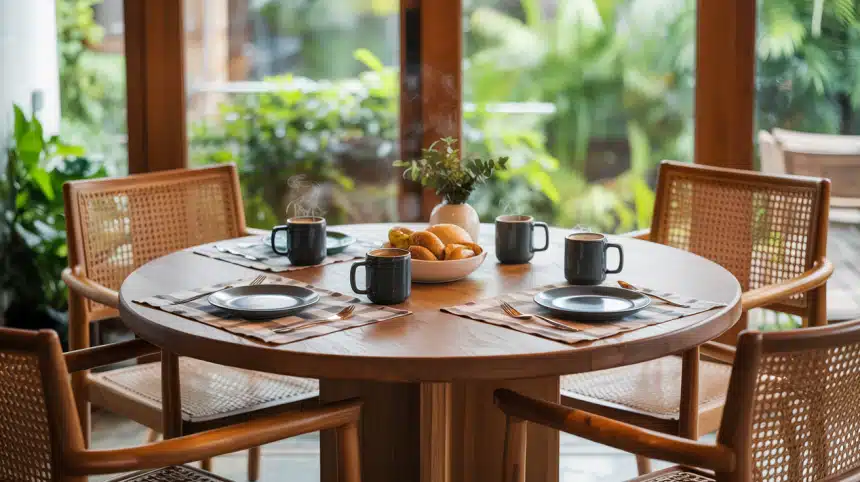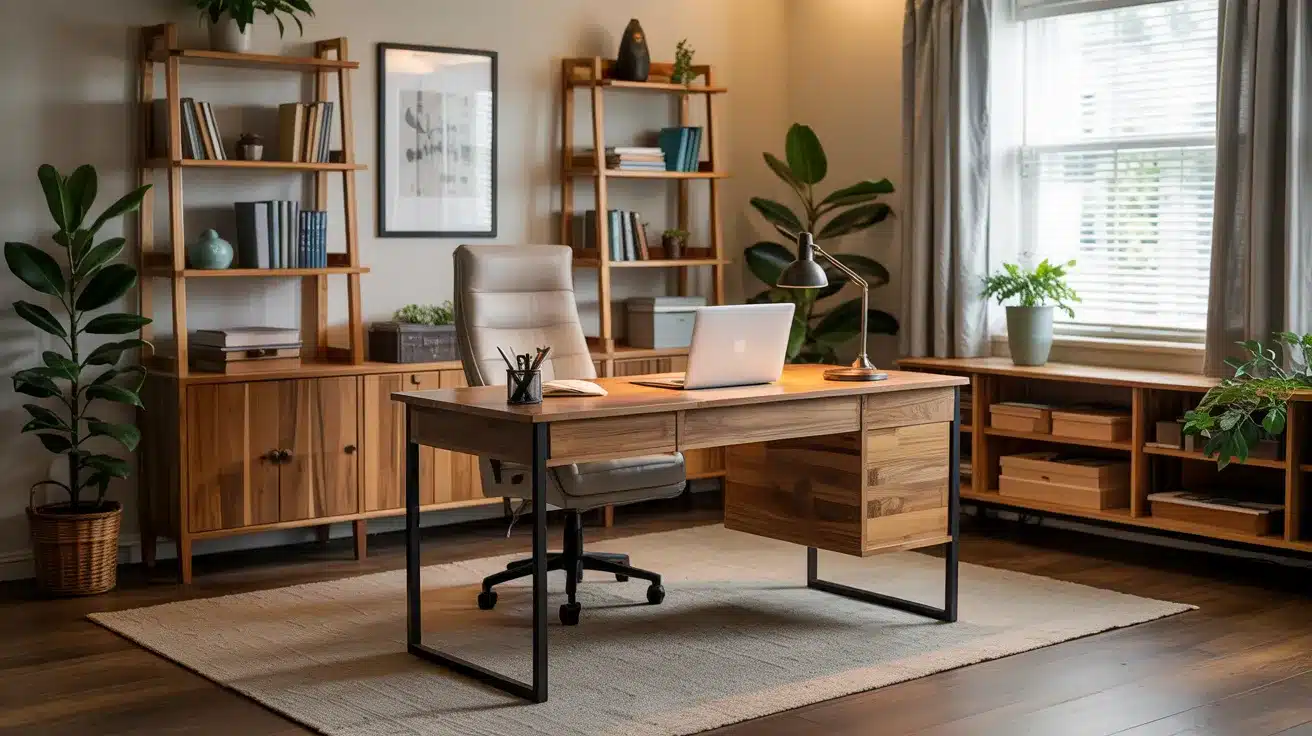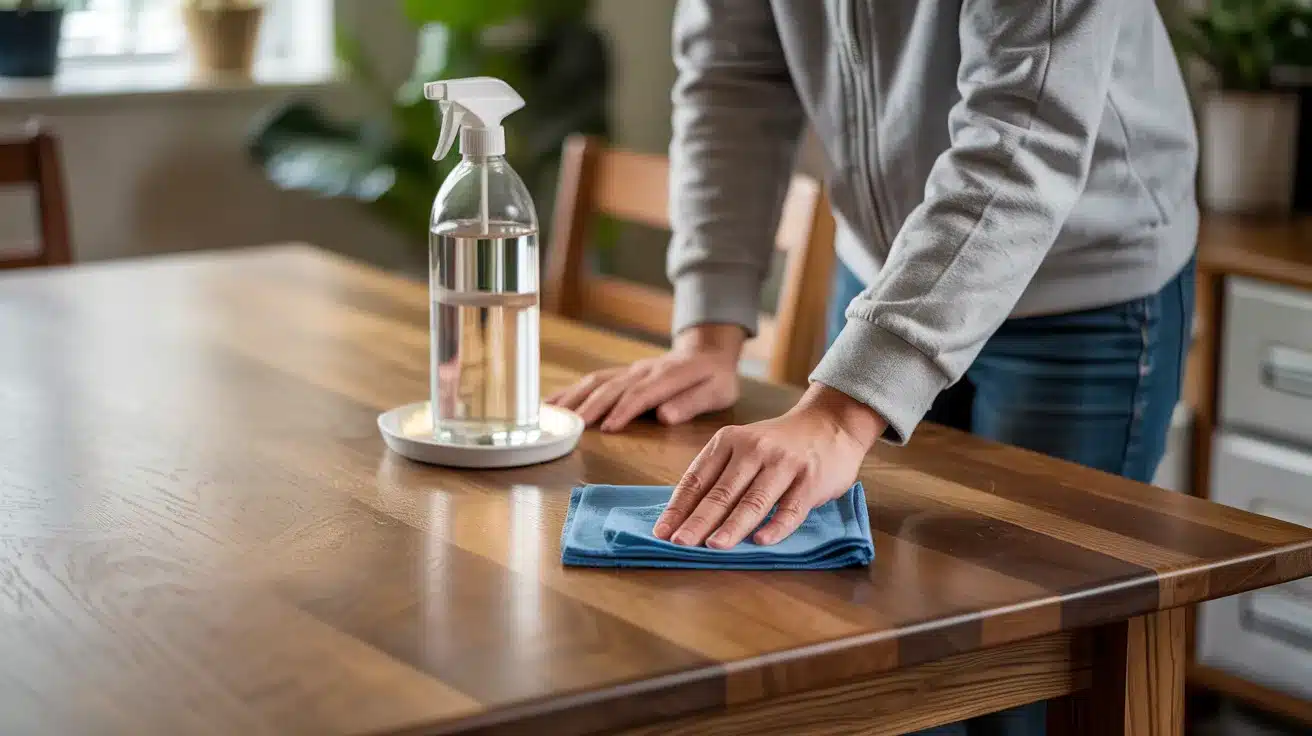Did you know common household items like your dining table or bookshelf might be made from the same trees that produce rubber? Many people are unaware of what rubberwood is, despite owning several items made from it.
When rubber trees stop making latex, they get a second life as wood. But is this material good for furniture? Is it strong enough? How does it compare to other woods?
If you’ve ever looked at wooden furniture and wondered about its source, you’re not alone. Rubberwood has quietly found its way into homes worldwide.
This guide explains what rubberwood is, why it matters, and how to determine if it’s the right choice for your specific needs. Let’s look at the facts about this often misunderstood material.
What is Rubberwood?
Rubberwood is a medium-density hardwood that comes from the Pará rubber tree. These trees primarily grow in Asian countries, including Thailand, Malaysia, and Indonesia. The scientific name of this tree is Hevea brasiliensis.
The most useful fact about rubberwood is how it is obtained. These trees first serve us by making latex for about 25-30 years. After they stop producing enough latex, the trees are converted into wood instead of being wasted.
Many people believe that rubberwood is a fake or mixed wood. This is not true. Rubberwood is real, solid hardwood—not an engineered product. The wood itself has nothing to do with rubber, except that it comes from the same tree.
The color of rubberwood is light, with slight hints of yellow or brown. Its grain pattern looks clean and simple. These features make it useful for many home items.
The Benefits of Choosing Rubberwood Furniture
When shopping for wooden furniture, your budget often guides your choices.
- Affordability: Rubberwood stands out as a more wallet-friendly option. You’ll pay less for rubberwood items than pieces made of oak, walnut, or teak. This makes it perfect for furnishing homes on a budget.
- Durability: The strength of rubberwood comes from its straight grain structure. This provides furniture that can withstand daily use without being too heavy. The wood won’t easily bend or break under normal weight.
- Eco-friendly: The green factor makes rubberwood a special material. Since workers cut these trees only after they stop making latex, no trees are grown just for wood. This helps forest land stay useful longer and reduces waste.
- Versatility in Staining: Rubberwood takes stains and finishes very well. This means your table or chair can match almost any color scheme in your home. The wood accepts paints and varnishes with ease, offering you numerous style options.
- Uniform Appearance: The wood has a smooth, even texture with minimal knots. This clean look works well for modern furniture styles and gives craftsmen a good base for detailed work.
How Does Rubberwood Compare to Other Hardwoods?
When selecting wooden furniture, understanding how different woods compare to each other helps you make informed choices. Let’s see how rubberwood matches up with some common hardwoods you might find in stores.
The main factors to consider are cost, durability, appearance, and weight. These points matter most when you’re trying to find the right wood for your home.
| Feature | Rubberwood | Oak | Walnut | Teak |
|---|---|---|---|---|
| Cost | Low to medium | Medium to high | High | Very high |
| Weight | Light to medium | Heavy | Medium to heavy | Heavy |
| Hardness | Medium | High | Medium to high | High |
| Color | Pale yellowish | Light to medium brown | Dark brown | Golden brown |
| Grain pattern | Straight, simple | Prominent, wavy | Rich, varied | Straight with oils |
| Stain absorption | Excellent | Good | Limited (often left natural) | Limited (oils resist) |
| Typical lifespan | 5-15 years | 20+ years | 20+ years | 25+ years |
| Best uses | Indoor furniture, toys | All furniture, flooring | Fine furniture, accents | Outdoor furniture |
This table illustrates the primary differences between these woods. Now, let’s examine each wood type more closely to see what makes it unique.
What Makes Rubberwood an Ideal Eco-Friendly Choice?
People who care about the planet often want to know the origin of the wood used in their furniture. Rubberwood has several special features that make it a good choice for those who consider the environment.
Sustainability Factors
- Second-life Resource: Rubberwood is derived from trees that have completed their full lifecycle, producing latex. When these trees stop producing enough latex, they are still cut down anyway. Using the wood means we get two products from one tree.
- Short Maturity Time: Most hardwood trees mature relatively quickly. Oak trees typically take 80 to 100 years to reach full maturity. Maple trees usually take 40-60 years to mature. However, rubber trees reach a useful size in just 7-10 years and can produce latex for 25-30 years.
- Reduced Waste: Without the furniture industry, most old rubber trees would be discarded as waste or used as firewood. Making furniture from them keeps carbon locked inside the wood for a longer period.
- Less Land Use: Because each tree serves two purposes (latex and later wood), we need less land to grow trees. This helps keep more natural forests safe.
Certifications
When buying rubberwood items, look for these marks of good forest management:
- FSC (Forest Stewardship Council): This label indicates that the wood originated from forests managed in a manner that protects plants, animals, and local communities.
- PEFC (Programme for the Endorsement of Forest Certification): Another trusted mark that shows the wood came from forests kept in good health.
These stamps help you know your furniture didn’t harm forests. Many rubberwood products now come with these marks, making it easier to shop with a clear mind.
How to Care for Rubberwood?
With proper care, your rubberwood furniture can stay in good shape for many years. Adopting the right cleaning habits and precautions will help you maximize the value of these items.
1. Basic Maintenance
Regular dusting keeps your rubberwood furniture looking its best. Wipe it with a soft, dry cloth once a week to prevent dirt from accumulating in the grain. Keep these items away from windows that receive strong sunlight to avoid fading and drying. Always use coasters under drinks and mats under hot dishes to prevent damage. Avoid placing furniture near heat sources, such as fireplaces or vents.
- Regular dusting with a soft cloth
- Avoid direct sunlight exposure
- Use coasters and mats to prevent moisture damage
- Keep away from heating vents and fireplaces
2. Cleaning and Sealing
For sticky spots, use a cloth with mild soap and water, but make sure it’s barely damp. Dry the wood right away with a clean towel. Avoid harsh cleaners that can strip the finish. Apply furniture wax or polish once a year to maintain protection. Touch up small scratches with a matching wood marker as needed.
- Clean with mild soap and a barely damp cloth
- Avoid ammonia, bleach, or strong cleaners
- Re-seal with furniture wax annually
- Fix small scratches with touch-up markers
3. Avoiding Common Damages
Control humidity in your home to help prevent warping of rubberwood items. Aim for a humidity level of 40-50% for optimal results. Clean spills immediately before they can soak into the wood. When moving furniture, always lift rather than drag to protect the finish and joints. Check regularly for loose screws or joints and tighten them promptly.
- Maintain consistent humidity (40-50%)
- Clean spills immediately
- Lift furniture when moving it
- Check and tighten joints regularly
The Pros and Cons of Rubberwood
Before you decide on rubberwood for your next furniture purchase, it’s helpful to weigh both its advantages and disadvantages. Every wood type has its strengths and limits, and rubberwood is no different.
Here’s a clear look at what makes rubberwood a good choice and where it might fall short:
| Pros | Cons |
|---|---|
| Cost-effective: Much more affordable than most other hardwoods | Not very moisture-resistant: Can warp or rot in damp conditions |
| Eco-friendly: Repurposes trees that would otherwise be discarded | Softer than many hardwoods: More prone to dents and scratches |
| Takes finishes well: Accepts stains and paints smoothly and evenly | Limited natural color options: Lacks the rich hues of woods like cherry or walnut |
| Lightweight: Easier to move and rearrange than heavier woods | Shorter lifespan: Typically lasts 5-15 years with normal use |
| Minimal shrinkage: Holds its shape well after proper drying | Needs good sealing: Can be prone to insect damage if not properly treated |
These cons don’t mean rubberwood is a bad choice. They point to where and how this wood works best. For indoor items that are away from moisture and direct sunlight, rubberwood can serve you well while saving money.
Conclusion
Rubberwood offers a sweet spot of value, looks, and earth-friendly appeal. You now know this wood comes from trees that have already served a full life making latex.
The primary strengths of rubberwood lie in its affordability and its ability to accept various finishes. While it won’t last as long as oak or teak, proper care can extend its life.
For indoor furniture in dry areas, rubberwood is a perfect choice. Its light color works well with many home styles.
Next time you shop for furniture, check the label. You might find that rubberwood meets your needs without emptying your wallet.
What matters most is selecting wood that aligns with your lifestyle and values. Would you choose rubberwood for your home?




